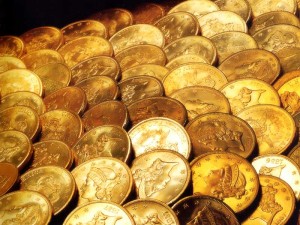 It’s been a hot start for gold in 2015 with oil, stocks, and the euro nose diving. Even though it pulled back on Wednesday as the broader market rallied, gold prices were still up 2.5%. The S&P 500 has the precious metal on top of the leaderboard and the heavy hitters in gold enjoying the spoils of a peculiar start for the 2015 market.
It’s been a hot start for gold in 2015 with oil, stocks, and the euro nose diving. Even though it pulled back on Wednesday as the broader market rallied, gold prices were still up 2.5%. The S&P 500 has the precious metal on top of the leaderboard and the heavy hitters in gold enjoying the spoils of a peculiar start for the 2015 market.
So why is gold doing so well? Some experts say the spike has to do with renewed suspicions in Europe, most notably the Greek elections and the potential nomination of the Syriza party come January 25th. Some fear that if the Syriza party takes office, it could lead to the Greeks departure from the Eurozone. Market analysts are beginning to worry as the term “Grexit” has resurfaced in discussions. However, gold seems to benefit from political unrest.
Prices rose to a record high above $1,900 an ounce the last time Europe had concerns about Greece in 2011. From then on gold investments have been doggish. Even the most recent rise has only seen gold trading around $1,210 an ounce, roughly 60% under the all-time high. Investors last year enjoyed a similar spike as they worried about the wellbeing of the aptly-named Fragile Five emerging markets. Back in the first two months of 2014, the GLD ETF experienced a 10% surge, but eventually finished the year down 4%, its second consecutive annual loss.
Some experts, including Jason Pride, the director of investment strategy for asset management firm Glenmede, doesn’t think investors should be after gold. Pride estimates a fair gold value should be around $1,000 and $1,200 an ounce. “There is no compelling reason that gold looks attractive,” says Pride. “The fact that it’s rising is more due to the latest situation with Greece. Gold often rises the most when there are government stresses.”
With safe havens back in fashion on Wall Street, Pride might be spot on. There is a substantial rush by investors for U.S. Treasury Bonds, and CNNMoney’s Fear and Greed Index is reading extreme fear. But in a market with increasingly high-flux tendencies, recent anxieties could be fleeting. And let’s not forget about the growing expectation that the European Central Bank will begin a round of asset purchases much like the quantitative easing programs exercised by the Federal Reserve and Bank of Japan. If that were to happen, the euro could take an even more dramatic hit than previously forecasted.
“Global money printing — first by the Fed, now by Japan and likely soon by Europe — is sowing the seeds of future inflation. That may be years from now, so it’s not an immediate concern. But that’s why we believe investors should have a small allocation to gold or other inflation-correlated assets in their portfolio.” ─ written by analysts from USAA Investment in their 2015 market outlook.
Owning some gold, whether the metal itself or ETFs tied to it, makes sense for some investors starting out 2015. But don’t get too caught up in the hoopla. While a minor insurance investment makes sense given recent stirrings in the global marketplace, anything more should be considered an over investment with its fair share of warning signs.

















